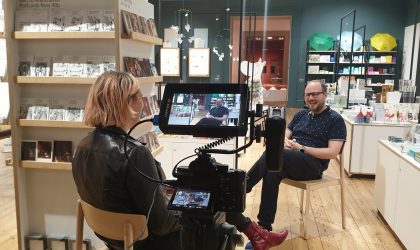How to develop a ‘Pull’ eCommerce Strategy and unlock your online revenue growth

Artsmark – Northway Primary School, Photo @ Xavier Fiddes
For creative and cultural organisations, eCommerce can be an exciting area to generate revenues to support your organisation. However it can also sometimes feel ideologically challenging for organisations – we have to fight to get airtime within our communication channels, and somehow eCommerce can end up feeling like the slightly too-commercial side of things. In this world, the eCommerce operation can become the somewhat unloved bolt-on.
This article shows that by developing a ‘Pull’ eCommerce strategy, that feeling can be turned around and an organisation can put itself in a strong position to grow revenue.
Push vs Pull Strategy
The origins of the word ‘strategy’ reach back to the ancient Greek words stratos, ‘army’ and agein, ‘to lead’. Many dictionary definitions still start with references to military leadership. So in this world we understand strategy to be akin to military planning – an assessment of resources and how best to deploy them.
Following this logic, we reach our typical ‘Push’ eCommerce strategy. An organisation may assess its resources, and identify that it has a website with some visiting traffic and some existing stock, therefore it should also sell these online – or ‘push’ these to its existing online audience. This works, and there is nothing wrong with it per se, but because cultural organisations exist to serve broader missions, it can sometimes feel awkward and it can feel like there is a ceiling to revenue growth.
To avoid this limitation, instead, organisations can think about what can ‘Pull’ customers in. What is the relationship they want to have with the organisation and what drives their decisions to shop with a cultural organisation? In my experience of helping many creative and cultural organisations, the ‘pull’ factors – what customers want from organisations – include:
- Memories
- Uniqueness
- Inspiration
- To share/display their love of art/culture
- To have cultural references in their daily lives
If we have this in mind, we can see how doing eCommerce well, becomes all about the relationship we have with the customer and how we can belong in their life. With this starting point, the eCommerce strategy we formulate feels very different. It no longer feels like an awkward ‘push’ but instead grows from a ‘pull’ which is harmonious with an organisation’s overall mission.
Ingredients for a ‘Pull’ eCommerce strategy.
There are three key ingredients that come together to form a successful ‘Pull’ eCommerce strategy. These are product range, trading plan, and eCommerce operations.

They can be thought of and developed as distinct areas, but it’s important to understand that they naturally overlap and they come together as a whole, that gives us our ‘Pull’ eCommerce strategy.
Think Product
Good product is at the heart of good eCommerce. Without great products, we’re stuck in a ‘push’ world, rather than benefitting from great products, which exert a natural ‘pull’ on our customers. So how do we develop a great product range for our online customers? Well, we develop products which are closely aligned to the ‘pull’ factors of our organisation and the occasions in our customers lives.
Thinking in this way leads us to consider:
- products related to exhibitions themes
- products related to seasonal occasions
- products related to the local area
- products related to the organisation interest area
The strongest products that we can develop are those which are unique to our organisation, relate to our organisation’s mission and to our customer’s life. A great way to develop unique product ranges is to collaborate with local makers and artists. Good examples of this approach include:
Also, it is important not to underestimate the role of gifting in retail for cultural and creative organisations. Helping our customers to prepare for seasonal occasions such as Mother’s and Father’s Day, the Festive season, as well as the birthdays of friends and family is vital. There are certain product categories that are highly giftable:
- Mugs – most people use them, there are no issues with sizing, unlike clothes and they are highly customisable. Offering a number of visually appealing options can be a good commercial move.
- Socks – again most people wear them, particularly good for ‘difficult to buy for’ people. Though they are a sized product, there isn’t a huge range of sizes to deal with.
- Scarves – these can vary from wool to silk and are a very popular gifting item.
- Blankets – at heritage properties these are often reported to be a bestselling item.
Beyond physical range development, it is also worth thinking about other areas for product development, which could include:
- Gift Vouchers – these could be for the shop, tickets, or special experiences such as Afternoon Tea.
- Memberships – how can these be brought to life, so an online customer understands the full value of the offer?
- Print-On-Demand – are there possibilities to develop your product range using images from your archives? These could be used to develop everything from art prints, to mugs, to cushions … the sky is your limit! Suppliers such as King & McGaw are known for specialising in high quality art prints, while suppliers such as Prodigi can open your eyes to the breadth of products that can be brought to life with your archives.
Develop a Trading Plan
Your Trading Plan helps you plot out your retail activity, highlighting the key areas which will be of interest to customers throughout the year. For some organisations it will make sense to look at this week by week, but for others, a monthly plan will make more sense.
For most organisations, the Trading Plan will include:
- The arrival of new products – particularly limited editions or seasonal items.
- Launch of whole ranges.
- Special offers or promotions.
- Products associated with particular seasonal occasions.
- Last Posting dates in December.
Essentially it is a plan of what is interesting for your customers on either a weekly or monthly basis. It is a schedule of ‘what’s happening’ in retail, which you can then use to inform your marketing efforts and share with communications colleagues.
A good way of thinking about it is as a schedule of ‘reasons to talk to your customer’, which will then naturally flow through to the marketing calendar. It also helps you to plan ahead and make sure you’re ready for each of these moments on your Trading Plan.
Understand the shape of your eCommerce Operations
Understanding the shape of your eCommerce Operations and how they are performing is really vital and will help you know where to focus your energy and resources. What can we look at? A useful way of looking at the ‘shape’ of our operations is to consider the Online Revenue equation.

This equation shows that if we want to increase our online revenue, we have three levers that we can act on:
- Traffic – looking at our marketing activity and how we can attract more visitors to our website
- Conversion Rate – improving the online customer journey to encourage more customers to complete their purchase
- Average Order Value – encouraging customers to spend more, typically through promotions and delivery thresholds
Is the site one which receives lots of traffic, but has a poor conversion rate, below 2%? If so our efforts would be best focused on identifying ways to improve the Conversion Rate. Whereas if you have a healthy conversion rate of 2-3%+, then it would be most fruitful to put your efforts into attracting more traffic to your website.
Looking at this overall ‘shape’ of your eCommerce operations will help you identify where you should focus your efforts. It is also important to monitor the shape and performance of your operations over time. Ultimately we care about the direction of our metrics, rather than the absolute values.
The next level of attention is to breakdown this ‘shape’ or equation, to understand what it looks like at a more granular level. The two most important ways to do this are to look at how it varies by:
- Geography – how does your website perform for visitors from different countries?
It’s quite normal for UK-based organisations, to attract the majority of their traffic from the UK and for that traffic to have a stronger conversion rate than that of traffic from other countries. It’s good to get a general feel for the ‘shape’ of this traffic by country. If you identify a significant chunk of traffic coming from a particular country, it can be worthwhile identifying if there might be actions you could take that could improve the conversion rate. One of the biggest ways to improve the conversion rate for international traffic is to make sure you have an appropriate delivery service, and it is clearly explained on your website.
- Traffic Source – how does your website perform for traffic from different sources?
By different traffic sources, we mean how that traffic reached your website, which could include:
- Direct traffic – someone entered your website address directly in their browser.
- Organic Search traffic – someone reached your website from a search engine result.
- Paid Search traffic – someone reached your website from a paid search campaign.
- Email traffic – someone reached your website from an email newsletter.
- Social Media traffic – someone reached your website from a social media post or profile. This can be broken down again into individual traffic sources.
What we want to do is to understand the ‘shape’ of these traffic sources – which are your largest traffic sources? Which sources of traffic have the strongest conversion rate? Looking at this information, what opportunities can you identify? Is one traffic source converting particularly well? If so, you might want to focus on growing traffic from that source. Does one traffic source seem particularly low? If so you might want to target growing traffic from that source.
As you start to spend time looking at your data, you’ll start to get a feel for the ‘shape of your operations’ and it is this in combination with your Trading Plan and your Pull Products which will come together to unlock your online revenues.
What next?
The Digital Culture Network is here to support you and your organisation. Our Tech Champions can provide free 1-2-1 support to all arts and cultural organisations and individuals who are in receipt of, or eligible for, Arts Council England funding. If you need help or would like to chat with us about any of the advice we have covered above, please get in touch. Sign up to our newsletter below and follow us on Twitter @ace_dcn for the latest updates.










